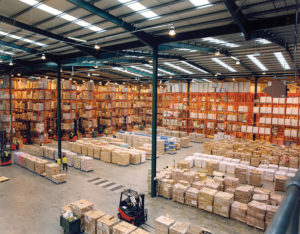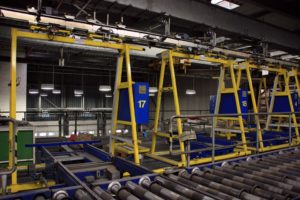Metal fabrication is a growing industry that supports some of the country’s most lucrative sectors, including manufacturing, aerospace, and construction. It has faced challenges in recent years, as have all industries, but in financially taxing times, it’s one of the few areas that seem to be on the rise.
Is it a good time to run a steel fabrication business? Possibly. But if you decide to take this step, it’s worth noting that the average profit margin for metal fabrication companies is slim, and succeeding in this sector is no small feat.
In this guide, we’ll take you through the steps of taking a metal fabrication company from inception to stability and growth. If you already have a business and need tips on growing it, don’t worry, this info still applies. Just jump in at a relevant point—we won’t be offended if you skip a little!
Step One: Research and Prepare
Proper preparation prevents poor performance. It’s cliched, but it’s true.
The small business cemetery is filled with the failings of countless owners that got too excited, jumped the gun, and made a costly mistake that destroyed their business before it even had a chance to succeed.
The clock isn’t ticking. You don’t need to start tomorrow, next month, or even next year. First, run through these steps, and only when you have finished and are confident with the results should you continue.
Plan the Services You Will Offer
What is your specialty? Metal fabrication is an umbrella term that includes various services, so before you go any further, consider which ones you will offer. They vary from common services such as shaping, cutting, and welding to more specialist ones like powder metallurgy.
Consider the Equipment
Whether it’s coil processing, plate processing, cut-to-length, or sheeting and leveling, there are various jobs and machines to consider.
Make sure you have the necessary equipment to complete all of these services. You’ll also need to budget for these machines, and they’re not cheap.
If you don’t have a lot of capital behind you, consider renting or buying used machines. There are some clear downsides to these options, including the fact that you’re either buying old and worn machines or not fully owning what you buy, but the savings could be worth it.
Think About Your Employees
Metal fabricators earn around $40,000 to $60,000 a year on average, but these salaries may rise if you’re hiring experienced professionals, operating in a high-income area, or offering specific services.
Hire only the ones you need and consider both salaries and training when calculating costs.
Conduct Market Research
You need to know the market before you enter it. It sounds obvious, and yet it’s a step that many startups overlook. They either assume they already know everything or just don’t have the patience to learn, but you need to be an expert before you invest so much time and money into this sector.
Spy On Your Competitors
Can’t figure out what services to offer, what prices to charge, and how much profit you can make? Check your competitors.
The more you know about them, the easier it will be for you.
Success in business is largely down to trial and error. The same could be said for success at any level. Your competitors have already made big mistakes and learned from them, so see if you can get any info from them and the way they do business.
Plot the Supply Chain
Established metal fabrication businesses have reliable suppliers that they can trust. These suppliers may help them out in a pinch or provide discounted rates. If not, they will still be there when they need them, and they’ll know what to expect from each supplier.
If you’re just starting out, you don’t have that luxury. Everyone has to start somewhere, though, so check out metal service centers and other important suppliers—including any recruitment agencies you plan on using—and get an idea of cost, quality, and timing.
Look into Insurance, Regulations, and Other Requirements
Various regulations govern the metal fabrication sector. You also need insurance, and there may be other legal requirements based on your state and services. It’s a headache, but it’s best to get it all out of the way early, saving yourself a lot of hassle down the line.
Get a Business Plan
No one looks forward to writing a business plan, but it’s one of the most important steps. It gives you direction and meaning, and it also helps you to acquire the funding needed to move ahead.
Your plan should include everything you need, along with your analyses of competitors, equipment and staff costs, and the price of hiring employees.
Step Two: Invest in ERP Software
There are various software programs targeted at the steel and metal fabrication sector, including:
- Metal fabrication software
- Coil processing software
- Steel optimization software
- Metals nesting software
- Metal framing software
- Sheeting and leveling software
- Multi-line processing software
- Flat rolled software
You also have to consider accounting, human resources, invoicing, inventory management, and customer relationship management.
There’s a lot, but you don’t need various software programs and can meet all of these needs using a fully integrated metal fabrication ERP, such as the cloud ERP solutions available from RealSTEEL™.
This software provides a single source of truth across the whole business, accounting for all departments and processes. It drives productivity and efficiency and is used by everyone from metal service centers to steel fabrication companies.
Questions to Ask Before Implementing an ERP System
Ask yourself the following questions about metal fabrication ERP software to ensure you’re getting the best one for your needs:
- Can we track all inventory?
- Can we automate sales orders and invoices?
- Will we have complete visibility of all materials and production processes?
- Will it allow us to organize customer data and provide customer relationship management (CRM) services?
- Is the cost of the service justifiable?
- Will it be available in the cloud, on-site, or as a hybrid model?
- Will it be easy to manage customer specifications?
- How will the software help us to improve productivity, efficiency, and profitability?
- Can we keep track of machinery and workloads?
- Will it provide solutions related to human resources, including payrolls?
Step Three: Market Your Business
You’ve done the basics; you’ve gotten your business off the ground. But that business isn’t going anywhere if you don’t have customers.
Marketing a metal fabrication business is just like marketing any other business—build a reputation, target the right demographic, and keep existing customers happy while targeting new ones. The approach is slightly different, though:
Know Your Customers
Before you start targeting customers, you need to know who your customers actually are.
Your initial research may have given you the answers. If not, it’s time to go back to the drawing board.
Once you have that information, you can start targeting your marketing toward those individuals. Most advertising platforms offer targeted advertising these days, and they can get very specific. The more you know about your ideal customer, the easier it will be to find them and show them your ads.
Find Your Unique Selling Point (USP)
What sets you apart from the competition?
Every company needs a unique selling point, and that includes metal fabrication companies.
It doesn’t have to be completely unique, though. There is no such thing as a totally unique selling point. You just need to give yourself a distinctive profile, something that helps you to stand out and means you don’t get lost in the crowd.
Create Your Marketing Materials
Marketing starts with your website. It might not be the first thing that customers see, but it will be the thing that eventually converts, so before you spend big on offline and online ads, make sure your website is ready:
- Simplify the layout
- Make it very clear who you are and what you do
- Show social proof (if you have it) with testimonials/reviews
- Scream your USP from the rooftops
- Create content for your website and on social media to drive traffic and improve SEO
- Check your page speed and keep it high
- Confirm that your website works on all devices
Be Seen and Heard
A metal fabricator or steel service center relies heavily on repeat custom and word of mouth. So, get out there and network!
Attend events frequented by people who need your services and show them what you have to offer. Chat, swap names and numbers, and encourage them to tell their friends.
The results won’t be instant, and it will take time to get some momentum going, but as soon as you start completing orders for customers, the word will get out, and you’ll have new customers calling you before you know it.
Step Five: Scale Your Business When the Time is Right
You will probably have to start small in the beginning, but as the orders increase, you can start growing your metal fabrication business.
Scale Your ERP
ERP systems are highly flexible. They are built with scalability in mind.
If your orders have increased, your services have expanded, and you have more clients, employees, and machines, you can simply upgrade the system and add more modules.
That’s one of the great things about ERP—it can grow right alongside your business. It will raise the costs a little, but as with the initial implementation, this software will pay for itself very quickly.
Optimize Your Equipment
Your software isn’t the only thing that needs an upgrade. Your machinery should be given the same respect.
Again, it can seem like a big expense in the beginning, but the time you save by using more efficient machines and the money you save with reduced downtime will be worth it overall.
Newer machines also require fewer operators and less maintenance, allowing you to redirect some of those resources into other areas of your business.
Improve Your Labor Productivity
There is no point in hiring a skilled workforce if their skills are not properly utilized. Assess the current workload and check that everyone is being used in the right areas and you’re getting the most value out of them.
If you use their skills properly, you’ll benefit, your business will benefit, and your employees will experience a bump in job satisfaction.
Keep an Eye on Your Profit Margin
Your income and expenditure will undergo some serious changes as you grow your business, so keep a close eye on your profit margin and make sure you stay firmly in the black.
ERP software will help you to track all data in real-time, while giving you a clear overview of your current operations and finances. Watch this like a hawk, and if those profits drop, it’s time to take action!
Step Six: Manage Your Customers and Reputation
The final step to building a successful metal fabrication business is to monitor your progression and keep all of those plates spinning. ERP software helps with most of this, making it easier to keep track, but there are areas that require some personal input:
Get More From Your Employees
Are your employees performing to the best of their abilities? Are you getting everything out of them?
Training will help to keep them sharp and engaged while teaching them the latest tricks and showing them how to use the latest machines.
Build Your Brand
Branding is not just the reserve of influencers and ecommerce companies. Your brand is how your customer perceives you—it’s your story, your reason, and your reputation.
Keep it simple, create a unique style and approach, and stay consistent throughout all of your content and marketing.
Keep Your Customers Happy
Loyal customers are essential in this industry. You need new customers, sure, but if you don’t build brand loyalty and acquire repeat customers, you won’t make it beyond the first couple of years.
Offer the best customer support, deliver to spec every time, and if you make a mistake, apologize profusely and do everything you can to rectify the issue.
Try New Marketing Angles
Don’t stick with a single marketing option just because you heard it works for someone else. If it’s not doing what you need it to do, change the angle, try something new, and compare the results to what you were doing before.
This is where A/B testing can help. It entails creating two ads with a little change, targeting them toward different people from the same demographic, and then comparing the results. Keep the winning ad, create a new variation, and compare again.
Keep Researching
Market research shouldn’t be limited to those early stages before you launch. This business is changing all of the time, with new customer trends, new industries, new technologies, and new methods.
Keep an ear to the ground to learn about these changes. Train yourself and your staff, and stay informed about your competitors and the industry.
Summary: Building a Successful Metal Fabrication Business
Although metal fabrication is a lucrative industry, it’s not an easy one. It can be costly and high-risk, and even when you get it right and things go your way, the margins may be very slim. Still, it’s a growing sector rife with opportunity, and if you have the right ERP supporting every employee and production process, there’s no reason why you can’t make it a success.




